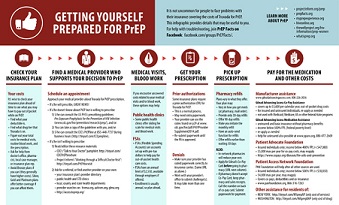
How to Pay for Your Prescription.
PrEP is expensive if you have to pay for it out of pocket. There are programs in place to help make it affordable (and sometimes even free!) whether you have insurance or not.Note: This page is solely about paying for the prescription. The next page discusses issues such as your doctor/clinician and lab visits.
I do not have insurance.
- If you are a U.S. resident, consider enrolling in an insurance plan either through your workplace (if offered) or through the ACA insurance marketplace. Note that there are usually specific enrollment periods, so you may have to wait to enroll.
- If you are unable to enroll in an insurance plan, check with local PrEP providers to see if they offer reduced-cost or free services to get on PrEP.
- If you make below 500% of the federal poverty level (2017 amount is $60,300 for an individual), you qualify for Gilead's Medication Assistance Program.
- Unfortunately, if you make above 500% of the federal poverty level and do not have insurance, you will probably have to pay for your PrEP prescription out of pocket.
I have insurance.
- Check your insurance plan to see if it covers PrEP. What will your deductible be? Do you need to get a prior authorization from your doctor/clinician to get the prescription?
- Do you have a Flexible Spending Account or a Health Savings Account? If you do have out-of-pocket expenses for PrEP, consider opening one of these accounts if they are available to you.
- Regardless of your income, you should qualify for Gilead's Advancing Access Co-Pay Card, which pays a max of $3,600 per calendar year toward Truvada copays.
- Depending on your income level, you may also qualify for a couple of other grant programs to cover prescription costs. Check out:
- Patient Access Network Foundation (must be at 500% of Federal Poverty Level or less)
- Patient Advocate Foundation (must be at 400% of Federal Poverty Level or less)
